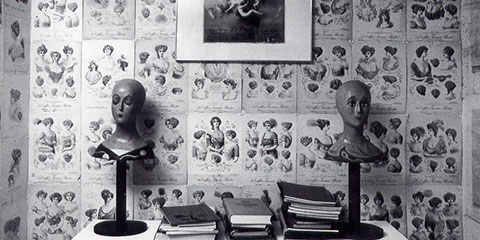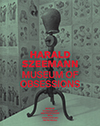Tuesdays and Thursdays at 2:00 pm
Feb 6–May 3, 2018
- To schedule a guided tour of 15 people or more, please contact gritours@getty.edu
- Book a school tour
Wrapped Kunsthalle, Bern, Switzerland, 1967–68, Christo and Jeanne-Claude. Part of 12 Environments: 50 Years of the Kunsthalle Bern, Bern, 1968. The Getty Research Institute, 2011.M.30. Photo: Balthasar Burkhard. © Christo
Front and back of Harald Szeemann's address list for his visit to New York, 1968. The Getty Research Institute, 2011.M.30
Oase No. 7 (Oasis No. 7), Haus-Rucker-Co (Laurids Ortner, Manfred Ortner, Klaus Pinter, and Günter Zamp Kelp), 1972. Part of documenta 5: Questioning Reality—Image Worlds Today, Kassel, 1972. The Getty Research Institute, 2011.M.30. Photo: Balthasar Burkhard
Calling German Names, performed by James Lee Byars at documenta 5: Questioning Reality—Image Worlds Today, Kassel, 1972. The Getty Research Institute, 2011.M.30. Photo: Balthasar Burkhard. © The Estate of James Lee Byars
Harald Szeemann (seated) on the last night of documenta 5: Questioning Reality—Image Worlds Today, Kassel, 1972. The Getty Research Institute, 2011.M.30. Photo: Balthasar Burkhard
Office stamps from Harald Szeemann's archive, Maggia, Switzerland, ca. 1970–1974. The Getty Research Institute, 2011.M.30. From Adrian Notz and Una Szeemann, eds., Harald Szeemann: Obsession Dada (Zurich, 2016), vol. 3, p. 40. Composite photo concept and design: Studio Coco, Corina Künzli
Postcards from Harald Szeemann's collection of 'pataphysics material. The Getty Research Institute, 2011.M.30
From left, dancers Totimo, Suzanne Perrottet, Katja Wulff, Maja Lederer, Betty Baaron Samoa, and Rudolf von Laban at Monte Verità in Ascona, Switzerland, 1914. The Getty Research Institute, 2011.M.30. Photo: Johann Adam Meisenbach
Furniture designed by Karl Gräser, ca. 1900–1920. The Getty Research Institute, 2011.M.30
Enzyklopädie im Wald (Encyclopedia in the Forest), Armand Schulthess, 1952–1972. The Getty Research Institute, 2011.M.30. Photo: Ingeborg Lüscher
Poster for the exhibition Der Hang zum Gesamtkunstwerk: Europäische Utopien seit 1800 (Tendency toward the Gesamtkunstwerk: European Utopias since 1800), Zurich, Markus Raetz and Albin Uldry, designers, 1983. The Getty Research Institute, 2011.M.30. © 2017 Artists Rights Society (ARS), New York / ProLitteris, Zurich. Reproduction, including downloading of ARS member artist works is prohibited by copyright laws and international conventions without the express written permission of Artists Rights Society (ARS), New York
Model of Gabriele D'Annunzio's Il Vittoriale degli Italiani (The Shrine of Italian Victories) installed in Tendency toward the Gesamtkunstwerk: European Utopias since 1800 at Kunsthaus Zürich, 1983. Peter Bissegger, designer; Verena Eggmann, photographer. Photo: the Getty Research Institute, 2011.M.30. © Verena Eggmann, courtesy of Bernd Steiner (Verena Eggmann Papers, Zentralbibliothek Zürich)
Harald Szeemann lecturing in front of Werk Nr. 003 by Emma Kunz. The Getty Research Institute, 2011.M.30. Artwork courtesy Emma Kunz Zentrum. © Anton C. Meier
February 6–May 6, 2018Getty Research Institute
One of the most distinguished advocates of conceptual art and postminimalism, and a figure who became synonymous with the advent of globalism in contemporary art, Harald Szeemann (Swiss, 1933–2005) developed a new form of exhibition-making that centered on close collaborations with artists and a sweeping international vision of contemporary culture. Szeemann's exhibitions covered vast areas of research, challenging traditional narratives of art history and often embracing creative fields outside the visual arts. For each of his more than 150 installations and exhibitions, Szeemann added materials to his vast library and research archive, which he referred to as the "Museum of Obsessions." His museum comprised not only the physical place of the archive but also a mental landscape that encompassed all moments of genius and artistic intensity treated in Szeemann's exhibitions, both realized and unrealized, past and future.
See more
Tuesdays and Thursdays at 2:00 pm
Feb 6–May 3, 2018

Monte Verità Foundation
Featuring Harald Szeemann collection material

When Attitudes Become Form: Bern 1969/Venice 2013
Reconstruction of Szeemann's 1969 exhibition

The reconstruction of Harald Szeemann's
Grandfather: A Pioneer Like Us
Institute of Contemporary Art, Los Angeles
(Feb 4–Apr 22, 2018)
Harald Szeemann: Museum of Obsessions
Kunsthalle Bern (Jun 9–Sept 2, 2018)
Kunsthalle Düsseldorf (Oct 12, 2018–Jan 20, 2019)
Castello di Rivoli Museo d'Arte Contemporanea, Rivoli (Feb 26–May 26, 2019)
Grandfather: A Pioneer Like Us
Gerechtigkeitgasse 74, Bern (Jun 9–Sept 2, 2018)
Kunsthalle Düsseldorf (Oct 12, 2018–Jan 20, 2019)
Castello di Rivoli Museo d'Arte Contemporanea, Rivoli (Feb 26–May 26, 2019)
Swiss Institute, New York (June 27–August 18, 2019)

Harald Szeemann: Museum of Obsessions
Edited by Glenn Phillips and Philipp Kaiser
With Doris Chon and Pietro Rigolo

Harald Szeemann: Selected Writings
Harald Szeemann
Edited by Doris Chon, Glenn Phillips, and Pietro Rigolo
Translated by Jonathan Blower and Elizabeth Tucker